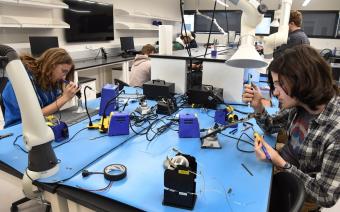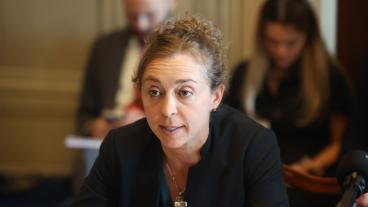Powering Up: Electrical Engineering Department at Colorado School of Mines grows as demand for jobs goes up

The future needs more electrical engineers, and the Electrical Engineering Department at Colorado School of Mines is readying students to meet that challenge.
With electrical engineering jobs expected to grow 9 percent over the next decade according to the U.S Bureau of Labor Statistics, EE grads have bright prospects across multiple industries.
“With industries increasingly electrifying their systems, electrical engineers are in demand,” said Peter Aaen, professor and head of the Electrical Engineering Department. “We’re investing in all the different areas where our grads are needed, whether that’s developing semiconductors or a new electrical grid or in related areas like quantum.”
The department’s student enrollment, both undergraduate and graduate, has grown 36 percent over the last four years and EE is responding to this increased demand with more opportunities for hands-on experience, research work and interdisciplinary projects.
“We’re growing and not only driving our own individual research areas but also partnering across many different departments and groups across Mines,” Aaen said. “We’ve been working with the Mining Engineering and Physics Departments and we’re looking to do more with Computer Science and Metallurgical and Materials Engineering. We often partner with and support other groups across the university, and there are so many opportunities to do so.”
Industry-focused education
One of the ways EE at Mines is extending its reach is through a new online professional master’s degree program. Launched in 2024 and designed in partnership with leading industry experts, the program is designed for working professionals in the industry who want to scale up their skills.
“Students get such a great education when they’re here in person,” Aaen said. “But for those already working in the industry or maybe Mines alumni who have been working for a while but want to come back and get a master’s degree, the online master’s program is a great option.”
The program has three stackable certificates – information and system sciences, microwave engineering, and power and energy systems – that students can complete online, with the option to attend certain in-person classes if interested. Certificates can be pursued independently or stacked together to earn the master’s degree.
"The certificates offered within the online EE master's were designed to provide students with targeted, career-relevant skills in a flexible online format," Aaen said. "This allows them to specialize in key areas, enhance their professional standing and build towards a full master's degree at their own pace."
New faculty and spaces, groundbreaking research
EE at Mines hasn’t just added more students and faculty – new research spaces have also been created to meet the department’s ever-expanding portfolio. New labs have been created, and existing ones have been recently updated to better suit the groundbreaking research being conducted within.
The Electronics Discover Center is a newly renovated space, located at the heart of the EE Department in Brown Hall and dedicated to student-led work. In this open lab workspace, students can complete course assignments, conduct self-driven research and realize Capstone Design projects. Roughly half of all Capstone projects each year include EE students.
Because of growing student enrollment, the department has also added more faculty, both as full-time electrical engineering faculty and through joint appointments shared with other departments at Mines.
One of those newer faculty members is Yamuna Phal, an assistant professor who joined the department in 2023. She recently received a $1 million grant from the National Science Foundation for research analyzing how chiral drugs interact with biological tissues, which could help improving the safety and efficacy of pharmaceuticals. She was also recently selected as a NASA Glenn Faculty Fellow and will be spending the summer working with the Photonics Division at NASA Glenn Research Center in Cleveland.
“I came straight to Mines after completing my PhD and jumped into my faculty position,” Phal said. “My experience has been nothing short of amazing-- from the Office of Research Administration to the Procurement and Contracting team, and the incredible mentorship I have received both within the EE Department and across campus. Many of my co-PIS and colleagues have shown a genuine investment not only in my success, but also in my well-being, which is something that's quite rare. The community at Mines is incredibly supportive and truly invested in helping you thrive.”
Specialized spaces for innovation
Along with Phal’s specialized lab, which focuses on developing infrared imaging and spectroscopic instruments, several other EE facilities have been built out to accommodate the research of department faculty, as well as student-led work. Those spaces include:
- ARC Lab – The Antenna, RFID, & Computational Electromagnetics Lab is equipped with advanced antenna test equipment, RFID development kits and computers with GPUs that can handle fast electromagnetic simulations and designs. Research in this lab, which also includes an antenna chamber that can perform far-field and near-field measurements, is led by Professor Atef Elsherbeni.
- PIC Lab – The Power, Intelligence, & Computing Lab supports power system modeling, simulation and control, fusion and application of AI/machine learning and advanced computing technologies for digitizing and transforming power and energy systems. Led by Associate Professor Qiuhua Huang, active projects include a collaboration with local energy companies to electrify, digitize and decarbonize low-income communities and an effort to develop data-driven and AI-assisted control for grid interactive buildings.
- Wireless Lab – Work in this lab, led by Assistant Professor Sihua Shao, focuses on reconfigurable intelligent surfaces, integrated sensing and communication, optical wireless communication, backscatter communication, machine-learning in communications and networking and drone-assisted wireless networks.
- ePower Hubs – This lab is home to high-voltage power electronics research and development, giving researchers and students the ability to design, fabricate, prototype and test their ideas. Projects in this lab are led by Assistant Professor Omid Beik.
- Microwave Lab – Equipment in this lab supports the development of electromagnetic biosensors in the microwave domain, the design and characterization of integrated microwave photonics devices and multiphysics modeling and measurement of nonlinear microwave devices. Research is led by Aaen and Assistant Professor Gabriel Santamaria-Botello.
Interdisciplinary work for the future
Research in the EE Department often reaches across departments and across the university, integral to programs and projects that look ahead to future needs.
A project by researchers in the ARC Lab, led by Elsherbeni, is one example of how the EE Department’s work cuts across departments. They have been developing a sensor data relay system for underground mining equipment, which communicates data from sensor-enabled cutting tools to the machine for control and maintenance management, allowing operators to better understand both the wear status of the tools and the type of rock being drilled. This project uses electrical engineering practices to contribute to mining safety.
The department’s work isn’t just Earth-based either—Beik was recently awarded a NASA Early Career Faculty Award for a project involving development of a high-power, high-voltage and high-speed electric generator for nuclear electric propulsion systems. These systems allow efficient electric power conversion that can be used to power deep-space missions, potentially opening the door for human travel to Mars.
Mines’ Quantum Engineering Program – one of the first graduate programs of its kind in the nation – is also interdisciplinary in nature, and EE is a key piece. Aaen is one of the quantum program’s faculty members and said the department plans on further developing its involvement in quantum at Mines.
“EE has world-class researchers on our faculty focused on finding solutions to current problems, as well as being invested and moving forward on things like quantum and other technologies that lay ahead,” Aaen said.




